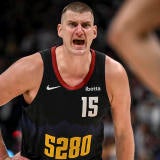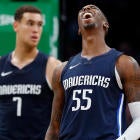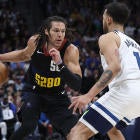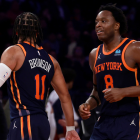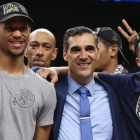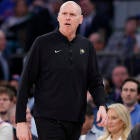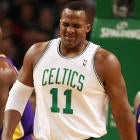The Dallas Mavericks didn't plan on having one of the best benches in the NBA. They wanted to follow the three-superstar blueprint that has led to so many championships in recent years, and aimed to unite Kemba Walker with Luka Doncic and Kristaps Porzingis to that end. That model tends to leave the back half of rosters depleted, as the Golden State Warriors can attest. That third pillar never materialized, though, and it forced the Mavericks into a pivot that, so far, is saving their season.
Without a superstar to splurge on, Dallas divided its resources methodically. Porzingis makes the max, and Tim Hardaway Jr. and Courtney Lee were imported with large contracts signed by the Knicks. However, the middle tier of their cap sheet reads almost like a typo in the all-or-nothing era of modern player movement. Dallas has five players making between $7.4 and $10.3 million, four of whom were signed this offseason.
Those signings have insulated Dallas from what was practically an inevitability. Porzingis has not looked the same since returning from a torn ACL. He is shooting below 40 percent from the field, isn't moving nearly as well defensively as he did as a Knick and Dallas is getting outscored by 5.7 points per 100 possessions when he is on the floor. Three-star teams can't afford to only have two stars, but teams with two can generate some leeway with strong depth.
That depth is the biggest hole in Doncic's MVP candidacy a month into the season. The second-year sensation is essentially just holding serve while he's on the court, as Dallas is outscoring opponents by only 0.7 points per 100 possessions in those minutes. When he sits, that figure jumps to 8.4 points per 100, and while the recovering Porzingis, with whom he shares around two-thirds of his minutes, can explain his own lower number, neither can explain the success Dallas has had with both stars on the bench.
Dallas' leaders in net rating so far are the ones at the bottom of its cap sheet. Perpetual small-sample king Boban Marjanovic leads the way at +31.6, but the true story of Dallas' bench is told through Jalen Brunson and his somewhat more sustainable +12.2 figure. Though a point guard in name, Brunson has thrived in a timeshare arrangement alongside several other Dallas ball-handlers. Lineups with Brunson, Hardaway and Delon Wright have been particularly potent. Such lineups are almost entirely populated by those mid-tier salaries that, on a more traditionally built contender, would instead be veterans making the minimum.
Putting that much skill on the floor at once turns even simple actions like pick-and-rolls and dribble handoffs into maddening wars of attrition for defenses.
Such lineup configurations are fairly common among starters, where defenses are prepared for an opponent's best players. Bench units tend to lack that kind of talent and any subsequent sophistication, making Dallas somewhat unique in that respect. Most teams struggle to find one capable ball-handler for their bench, and need to stagger their best players as a result. Dallas can casually toss three at an opponent at once with not a starter to be found.
It is a role that many point guards would chafe at, but that Brunson was uniquely qualified for as a prospect. "In college, we had a guard-heavy offense, so a lot of the guys really handled the ball," Brunson told CBS Sports of his time at Villanova. "So just bringing it to the league is kind of second-nature to me."
Dallas has played this way for a decade now, and surely noted the similarities between him and longtime bench star J.J. Barea during the evaluation process. While Brunson is a good deal bigger, his low center of gravity and fluidity in changing directions are straight out of the Barea playbook. The Mavericks have a type, and even the players know it.
"I think it's a stable organization," Seth Curry says. "They've had the same coaching staff for the most part, the same management for a long time, so they know the guys that come through this organization. They give great opportunities to guards like myself and J.J. that can play on the ball and off the ball." Curry, like Barea and Devin Harris before him, left Dallas in search of greener pastures before eventually returning.
If Brunson is the new Barea, Curry is something closer to Jason Terry as a sparkplug scorer and ancillary spacer for the starters. While some teams would view the two as redundant, Dallas makes sacrifices in other areas in the name of spacing. Size is the biggest. Justin Jackson, for instance, came into the NBA as a 3-and-D wing, but he shot only 33.5 percent from behind the arc in his first two seasons. Now Dallas is playing him primarily as a power forward. The results are symbiotic. The guards don't have unwieldy big men clogging their lanes, which in turn allows them to create better shots for players like Jackson, who is up to a career-high 41.7 percent on 3-pointers.
Whether it's Jackson, Maxi Kleber or Porzingis, Dallas always has at least one spacer occupying a front-court position. The non-shooting big men fill specific niches elsewhere. Dwight Powell is among the NBA's best pick-and-roll finishers. Marjanovic is the league's resident giant, a professional approximation of that one little-leaguer that just can't be the same age as all of the other kids.
The formula has worked for ages in Dallas. The Mavericks led the NBA in bench points per game in three of Rick Carlisle's first five years in Dallas, including the 2010-11 championship season. As the roster deteriorated, their best lineups continued to be led by bench players. Doncic finished 14th in net rating on last year's team, while Ryan Broekhoff led the way among players who saw meaningful minutes.
But this year's bench is so deep that Broekhoff has played only four minutes all season. That isn't a major achievement right now, but it soon could be. The way Dallas has structured its roster should terrify the rest of the NBA.
All five of those mid-tier salaries, including the final year of Doncic's criminally cheap rookie deal, are on the books for at least three seasons. So are Brunson and Dorian Finney-Smith. Nine Mavericks in total have played at least 200 minutes this season, and eight are under contract when the critical summer of 2021 arrive. Hardaway and Lee aren't, which puts Dallas, with Doncic, Porzingis and virtually an entire rotation, in position to create max cap space in the same summer Giannis Antetokounmpo becomes a free agent.
It's an ironic state of affairs. The team that tried to fast track its star trio by pursuing Walker last summer now essentially has a chance to build a superteam in reverse. Instead of clearing the decks to create the space for a third star and then filling the roster out afterward, the Mavericks would have an entire ecosystem in place for an arriving cornerstone.
Such a coup, be it Antetokounmpo or another superstar from 2021's loaded class, would be unprecedented, and would create a roster almost entirely devoid of holes. Superteams aren't supposed to get better when the bench players come in. Dallas, with this group, has a chance to buck that conventional wisdom and create one of the most complete teams in recent memory.







